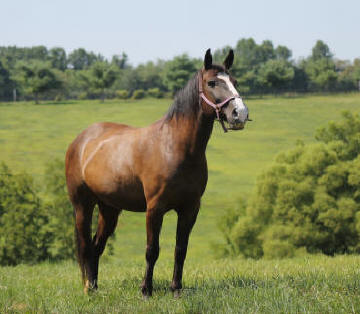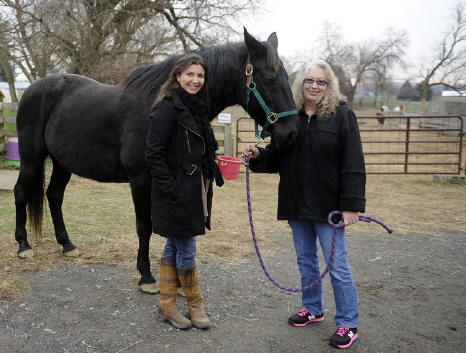Horse Rescues
Dr. Kimberly Brokaw, DVM
Walkersville Vet Clinic
 (4/2016) When a horse owner dies or suffers severe financial problems, the question often arises about what to do with their horse. Horses are expensive to maintain. Hay usually costs $100-$300 per month per horse. Horse shoers charge $40-$300, depending on the type of trim or shoes that
the horse needs. Most horses need to see the horse shoer about every 6 weeks. Proper care of a horse quickly becomes a financial burden when an owner is going through hard times. Some horses can be sold quickly to a new owner. Unfortunately, when an owner has been suffering poor health or financial reverses, the horse is often not in a condition to quickly be sold. Horses who
are taken to auction for a quick sale frequently end up being purchased by a kill buyer. The horses then may endure days of horrible conditions, before being slaughtered for meat.
(4/2016) When a horse owner dies or suffers severe financial problems, the question often arises about what to do with their horse. Horses are expensive to maintain. Hay usually costs $100-$300 per month per horse. Horse shoers charge $40-$300, depending on the type of trim or shoes that
the horse needs. Most horses need to see the horse shoer about every 6 weeks. Proper care of a horse quickly becomes a financial burden when an owner is going through hard times. Some horses can be sold quickly to a new owner. Unfortunately, when an owner has been suffering poor health or financial reverses, the horse is often not in a condition to quickly be sold. Horses who
are taken to auction for a quick sale frequently end up being purchased by a kill buyer. The horses then may endure days of horrible conditions, before being slaughtered for meat.
Rescues are a good alternative for placing horses into a good home. Good rescues provide high quality care. They also retrain horses so they can be adopted out to good, suitable, homes. Good rescues provide continued monitoring of the horses in their new homes, and will take a horse back into the rescue if the horse turns out to be an unsuitable horse
for the adopter. If a horse is in poor health, good rescues provide veterinary care. If a horse cannot be restored to good health despite extensive veterinary care, the rescue humanely euthanizes the horse.
 Horse rescues are supported by contributions from the public. Many animal lovers regularly send money to rescues so the rescues can continue their good work. Unfortunately, the amount of money that rescues receive attracts unsavory characters who claim to run a rescue so they can get people to send them money. Many animal hoarders accept donations,
claim to be rescues, but do not provide good care of their animals. The recent cases of such behavior has been in the news. A woman collected thousands of dollars of donations while operating as a tax exempt rescue yet starved and neglected the horses in her care.
Horse rescues are supported by contributions from the public. Many animal lovers regularly send money to rescues so the rescues can continue their good work. Unfortunately, the amount of money that rescues receive attracts unsavory characters who claim to run a rescue so they can get people to send them money. Many animal hoarders accept donations,
claim to be rescues, but do not provide good care of their animals. The recent cases of such behavior has been in the news. A woman collected thousands of dollars of donations while operating as a tax exempt rescue yet starved and neglected the horses in her care.
I frequently get asked by clients how to tell if a rescue is good quality. While regularly visiting a rescue, volunteering your time, and evaluating the quality of the care and standard of living provided to the animals is ideal, it is not always possible. A single visit unfortunately often does not provide an accurate depiction of the quality of a
rescue. There have been many cases where hoarders have hidden under the guise of a rescue, or well meaning people have rescued more animals than they could adequately provide for, and the quality of the care provided to the animals suffers.
Facebook and other websites can easily be deceptive. I am aware of one client who discovered that pictures of his farm were being used on the website of an alleged rescue that falsely claimed that was where their horses were being housed. The owner of that alleged rescue was later found guilty of around 11 counts of animal cruelty. Recently another
so-called rescue was shutdown and animal cruelty charges have been made. While that rescue was a tax-exempt rescue, funds were going to personal horses and rescue horses were not being adequately fed. While not all rescues are frauds, careful evaluation is needed to determine which rescues provide quality care for animals in need vs. ones that provide a situation that is no
better than what the animal was rescued from.
The Global Federation of Animal Sanctuaries (GFAS) is an organization that evaluates rescues, rehabilitation centers, and sanctuaries. They are the only globally recognized organization providing standards for identifying legitimate animal sanctuaries. They evaluate a variety of groups ranging from bat sanctuaries to equine rescues. However currently
they do not assess domestic cat and dog rescues. Rescues seeking accreditation are evaluated based on animal housing, physical facilities and administration, nutritional requirements, veterinary care, well-being and handling, general staffing, safety policies, protocols and training, governing authority, financial records and stability, education and outreach, as well as
policies relating to acquisition and disposition.
Different standards are established for each species. For example horses can not be contained in a fence made of barbed wire, high tensile wire, or razor wire as those are dangerous and put horses at risk for injury. Accredited rescues are also questioned to ensure that if personal horses are being kept at the rescue, there are means to ensure that
funds for the rescue are kept separate and not used on the privately owned horses. Obtaining GFAS accreditation requires a large commitment of time and money for the rescue to demonstrate that they meet all of the criteria of a high quality rescue.
The GFAS website provides a list of accredited and verified animal rescues. If you are contemplating donating your time or money to a rescue, check the website and find one in your area. By selecting an accredited rescue you can have some assurance that you are supporting a rescue that has been closely evaluated, and will use your money to actually
help horses. Some rescues that are not accredited are still good rescues.
If you are contemplating giving money to a rescue that is not accredited, make sure you check it out carefully. Go and volunteer for a few days. You will quickly realize that the horses are well fed, seeing a horse shoer regularly, getting good veterinary care, housed in adequate shelters, turned out in safe fencing, and actively being retrained so
they can find good adoptive homes. Your contributions to a high quality rescue are the difference between a good life and a life of misery and death for these horses.
Read other articles by Dr. Kim Brokaw